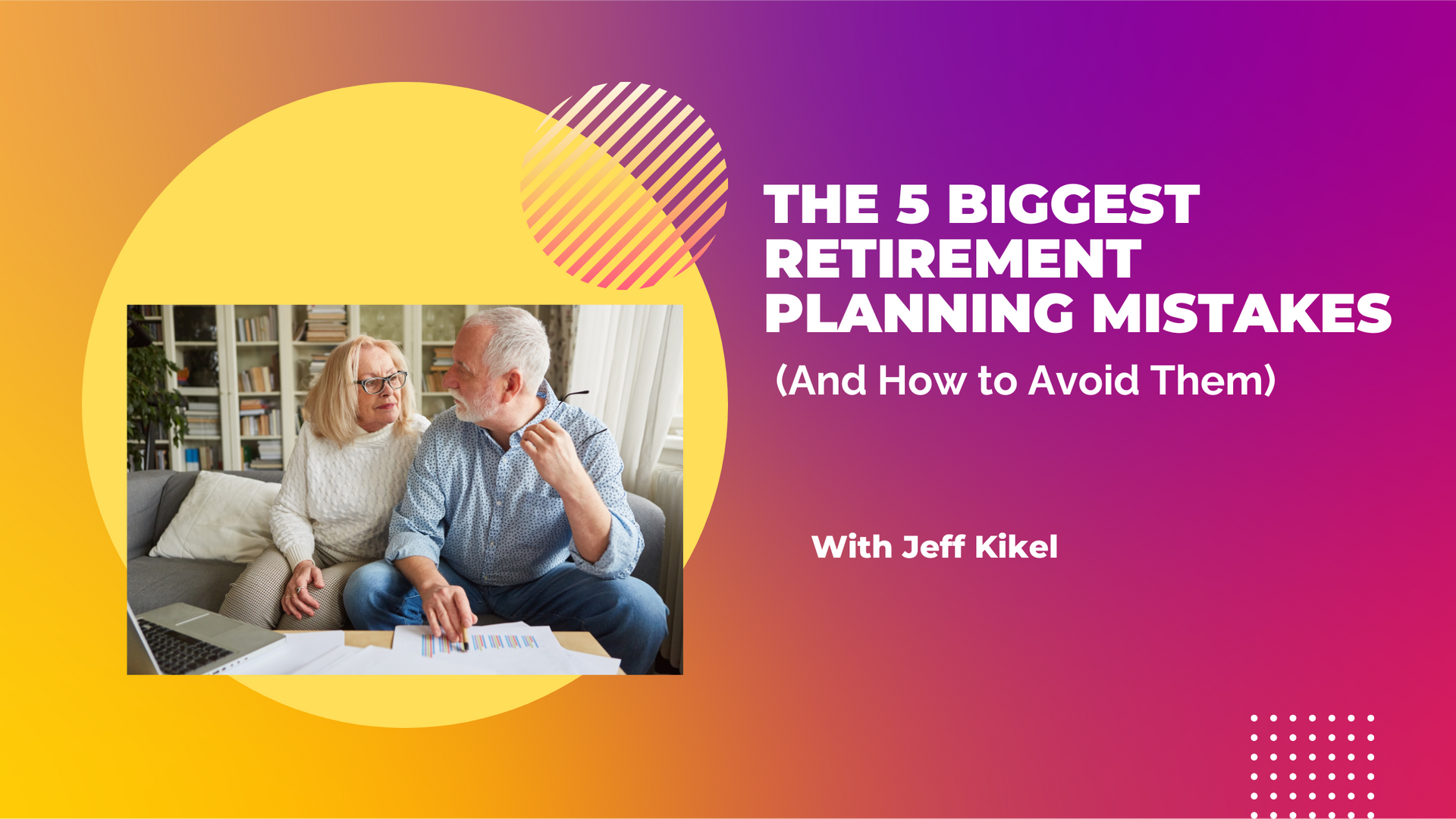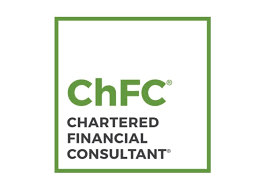The 5 Biggest Retirement Planning Mistakes (And How to Avoid Them)
This is a subtitle for your new post

Retirement Planning: It's Easier to Mess Up Than You Think
Have you ever woken up at 3 AM, staring at the ceiling, thinking, "How on earth am I going to retire?" You know you should be doing something—but what, exactly? And when? And how much is enough?
It's like that nagging feeling you forgot to lock the front door. Except instead of a door, it's your entire future.
If that sounds familiar, you're not alone. A lot of folks in their 50s and early 60s feel the same way. They've been working hard their whole lives, raising kids, paying the mortgage—but now retirement is getting real. And it's kind of terrifying.
I've been helping people plan for retirement for over 30 years, and let me tell you—I've seen some mistakes. Big ones. Costly ones. The kind that make people lie awake at night, wondering if they're going to run out of money.
But here's the good news: You don't have to make those mistakes. Today, we're going to chat about the five biggest ones I see all the time—and how you can avoid them. No jargon. No fancy talk. Just real-world advice, like we're sitting at my kitchen table, having coffee.
Mistake #1: Not Having a Defined Income Plan
Let me tell you about Dave and Lisa. Good people. Hard workers. They retired with what looked like plenty of savings—about $800,000. They figured they'd pull a little out every month, and it would be fine.
But here's what happened. The first few years of retirement were great. They took a cruise, helped their daughter with a down payment on a house, and fixed up their kitchen. Then Dave called me. He was nervous. "Jeff," he said, "I just checked our accounts, and we're down to $700,000. We've only been retired for five years. What are we doing wrong?"
What Dave and Lisa didn't have was a plan—a real plan for how to turn their savings into a steady, predictable paycheck in retirement.
Here's the thing: Retirement isn't about having a big pile of money. It's about knowing how to pay yourself from that pile for the next 30 years.
A 2023 Gallup poll found that 59% of Americans worry they won't have enough money in retirement (Newport, 2023). That fear? It often comes from not knowing how the money will actually work.
How to Avoid This:
Think of your retirement income like a three-legged stool:
- Social Security: Your foundation, but usually not enough on its own.
- Savings & Investments: This is where you create that paycheck.
- Pensions or Annuities: If you're lucky to have them, they give you a steady check.
What We Did For Dave and Lisa
When Dave and Lisa came to me, we sat down and built their Stress-Free Retirement Blueprint. First, we looked at their budget. Their essential expenses—mortgage, utilities, insurance, food—came to $7,000 a month. The fun stuff—dinners out, travel, hobbies—was another $1,200 a month.
We needed to cover the essentials no matter what, so we decided to start their Social Security at 67, which they had both just reached. That brought in $5,275 per month. To fill the remaining gap of $1,725, we took $300,000 from Dave's 401(k) and bought a Single Premium Income Annuity that paid them that amount every month for life, with a 20-year guarantee in case something happened to them early.
For the fun money, we set aside $72,000 in a 5-year Treasury bond ladder—that gave them $14,400 per year (or 1,200 a month) for the next five years. At the end of 5 years, this bucket would be empty.
The rest—$328,000—we kept in a growth portfolio. After five years, it only needed to earn 4.04% annually to replenish their discretionary spending.
Now? They sleep at night.
Mistake #2: Underestimating Healthcare & Long-Term Care Costs
A few years back, I worked with a couple—Bill and Mary. Bill was strong as an ox. He had never been sick a day in his life. Then he had a stroke.
Mary called me in tears. "Jeff, the home care is costing us $6,000 a month. We can't afford this." They had money, but they never planned for something like this. Who does?
The truth is that healthcare costs in retirement are brutal. Fidelity estimates that a typical couple retiring today will need $315,000 to cover medical costs (Fidelity, 2023). And that doesn't even touch long-term care like nursing homes or home health aides. Those can run over $100,000 a year.
How to Avoid This:
- Understand Medicare: It doesn't cover everything.
- Get a Supplement: Helps fill the gaps.
- Think About Long-Term Care Insurance: It can save you money later.
- Save for Health Costs: Even $300 a month into a health fund can help.
What we did for Bill and Mary
We set up a 5-year bond ladder from Bill's 401(k) to cover the $6,000 per month for home care. This became the healthcare fund that they knew they could rely on for the next five years. Then, we converted $75,000 from their taxable account into an asset-based long-term care policy. That way, if Mary needed care later, she'd be covered—or if not, their kids would inherit the money.
The rest—about $500,000—stayed in a growth portfolio to support Bill's future needs. If Bill lives beyond 5 years, we plan to use a reverse mortgage to help preserve their cash and leverage some of their home equity.
Mistake #3: Claiming Social Security Too Early (or Too Late)
Susan was 62 and had just retired after 35 years as a teacher. She was ready to start collecting Social Security. Her friends had all done it the moment they turned 62. "Better grab it while it's there," they said. "Who knows if it will run out?"
She was nervous. She had savings, but it wasn't as much as she hoped. She worried about the stock market. She worried about inflation. She worried she might run out of money in her 80s. So, collecting Social Security right away felt safe—like flipping on a safety net.
But when Susan and I sat down, we ran the numbers.
Starting Social Security at 62 meant her check would be 30% smaller for the rest of her life. That safety net? It would always feel a little short. Her monthly check would be significantly larger if she waited until her full retirement age of 67. And if she waited until 70, it would be even bigger. For Susan, that extra income later in life would be critical.
How to Avoid This:
- Be Patient (If You Can): Every year you wait, your monthly check grows.
- Consider Your Health: Taking it earlier might make sense if you have health concerns.
- Think About Your Spouse: Spousal benefits can be complicated but might increase household income.
What We Did for Susan
After weighing her options, Susan decided she could wait. Together, we built her Stress-Free Retirement Blueprint. We set aside five years' worth of low-risk investments to cover her living expenses. That money would give her the confidence to wait until she was 67 to start Social Security.
When she turned 67, she started receiving her full benefit—an extra $800 per month compared to what she would have gotten at 62. Over her lifetime, this would add up to over $200,000 more in income.
But the best part? Her investments stayed more intact because she didn't have to pull as much from her savings in those early years. We projected that her estate would likely be $300,000 larger by the end of her life.
Susan told me later, "Jeff, I sleep better knowing I'll have that bigger monthly check. I don't feel rushed or scared anymore."
Mistake #4: Not Accounting for Inflation & Market Volatility
Mark and Lisa had diligently saved their entire lives. When they came to me, they were just a few years from retirement. Their biggest fear? "We don't want to lose everything if the market crashes."
I get it. After all, the news loves to remind us of every dip in the market. And when you retire, those dips feel personal—because you depend on that money.
But there was something Mark and Lisa hadn't thought about: Inflation.
At just 3% inflation, prices double roughly every 24 years (Bureau of Labor Statistics, 2024). Today's $100 grocery bill could be $200 when you're in your 80s.
Mark looked me in the eye and said, "But we can just stay conservative, right? We don't want to risk it."
The problem is playing it too safe is its own risk. If your money isn't growing, it's shrinking. Slowly, silently. And you might not notice until it's too late.
How to Avoid This:
- Stay Invested: Keeping some money in growth investments (like stocks) helps you beat inflation.
- Have a Safety Buffer: Cash or bonds can cover your short-term needs, so you don't have to sell investments when the market is down.
- Balance Is Key: You don't need all risk or all safety—you need both.
What We Did for Mark and Lisa
We built their Stress-Free Retirement Blueprint. We set aside five years' worth of expenses in safe investments like bonds and cash. That gave them a cushion so they wouldn't have to touch their stocks during a market dip.
With that safety net in place, they felt comfortable keeping a healthy portion of their portfolio in growth investments. We even shifted some money from ultra-conservative accounts into stocks only after they understood the plan.
A year later, Mark called me. The market had a rough month, and he said, "You know what? I didn't panic. I knew we had that safe money. We let the stocks ride. I finally feel like we're going to be okay."
Mistake #5: Not Planning for Lifestyle & Purpose
John was 62 when he retired. The first few months were great. He slept in, played golf, and worked on his yard. But by the time we met a year later, he was restless.
"Jeff, I thought retirement would be all freedom and fun. But I'm kind of bored. And Jane and I are getting on each other's nerves a little."
That's more common than people realize. Retirement can feel like falling off a cliff if you don't know what you're retiring to.
The National Institute on Aging found that social isolation can increase health risks, including heart disease and depression (National Institute on Aging, 2023). We need purpose. We need connection.
How to Avoid This:
- Make a Plan Beyond Money: What will you do every day?
- Talk to Your Spouse: Retirement is a team sport.
- Find Purpose: Hobbies, volunteering, part-time work, travel—what excites you?
What We Did for John and Jane
We guided John and Jane through our Retirement Bucket List Exercise. It wasn't just about vacations. We had them list at least 10 things in each category:
- Places to Go
- Things to Do
- Hobbies to Try
- Volunteer Work (or a Part-Time Job)
- Relationships to Build or Strengthen
- Health & Fitness Goals
- Learning & Personal Growth
At first, it was hard. But once they started dreaming, they got excited. By the end, they had over 80 ideas.
Now? They take trips together. John volunteers at a food bank twice a month. Jane picked up painting. They both joined a hiking club. Their days are full, and their relationship is stronger than ever.
John told me, "Jeff, this list changed everything. We finally feel like we're living again."
You Don't Have to Do This Alone
Retirement doesn't have to be scary. But it does need a plan. Avoiding these five mistakes could be the difference between barely getting by and truly enjoying your retirement years.
That's why I created the Stress-Free Retirement Blueprint. It's not just about investments. It's about helping you feel confident—knowing your income is secure, your healthcare is covered, and your future is mapped out.
If you want to dive deeper into these ideas, I wrote a book just for you. It walks you through these common mistakes and how to avoid them—step by step. It is available on Amazon or the PDF is available for members on this site in the "Books" section.
Click Below
📖 10 Critical Mistakes in Retirement Planning (and How to Fix Them)
We also have a Masterclass available on our "Stress Free Retirement Project" Community. The community is FREE to join.
Visit the community at: www.Stress-FreeRetirement.com
Let's get you on the path to a stress-free retirement—because you deserve it.
Jeff Kikel is the President and Founder of Freedom Day Wealth Management and The President of Sure Horizon Retirement Advisors. Known as the "Stress-Free Retirement Guy," Jeff shares his knowledge on this site as well as through his YouTube Shows, "The Stress-Free Retirement Project" and "The Cents of Things". He is also the author of 10 books on personal finance and business. Jeff lives with his wife and business partner, Crystal, in Cedar Park, TX.
- Newport, F. (2023, May 18). Retirement remains Americans’ top financial worry. Gallup. https://news.gallup.com/poll/506259/retirement-remains-americans-top-financial-worry.aspx
- Fidelity. (2023). Retiree health care costs estimate. Fidelity. https://www.fidelity.com/viewpoints/retirement/retiree-health-care-costs
- Social Security Administration. (2024). Retirement benefits. https://www.ssa.gov/benefits/retirement/
- Bureau of Labor Statistics. (2024). Consumer Price Index Summary. U.S. Department of Labor. https://www.bls.gov/news.release/cpi.nr0.htm
- National Institute on Aging. (2023). Social isolation, loneliness in older people pose health risks. U.S. Department of Health and Human Services. https://www.nia.nih.gov/news/social-isolation-loneliness-older-people-pose-health-risks







